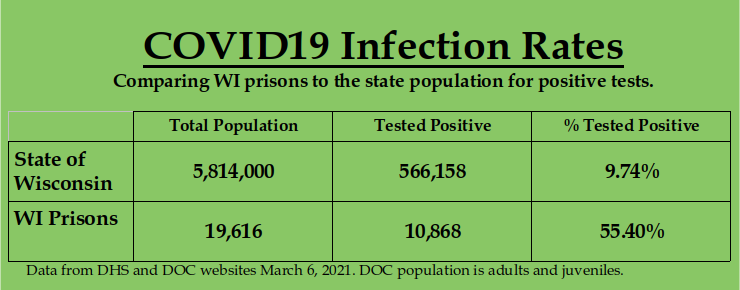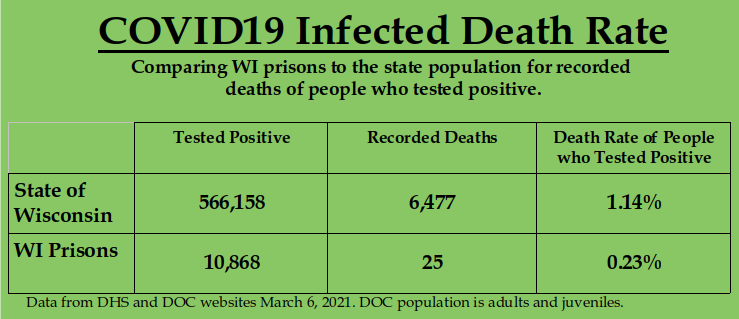On March 19, 2020 a prison doctor brought the coronavirus pandemic into the Waupun prison (WCI). As we approach the one year anniversary of this event, we want to review how Wisconsin has handled COVID in prison. Unfortunately, thanks to opaque bureaucracy and the unaccountable prison system (DOC), it’s impossible to make an accurate assessment.
The DOC has a COVID19 dashboard, where they release stats about testing, outbreaks and deaths. However, when we look closely at the data released there and compare it to statewide numbers from the Department of Health Services (DHS) everything doesn’t add up.
If the DOC undercounted and concealed COVID deaths, it will be difficult to know. They release very limited health-related records, and there is little oversight or concern about prison transparency from other government agencies or mainstream institutions. As a result, we can’t provide specific proof of an undercount, but, upon evaluating the numbers the DOC does release, there is plenty of cause for concern.
High Prison Infections
First, we know the DOC has failed miserably at containing the pandemic. The chart below compares statewide infection rates to infections of prison captives. While only about 10% of the state population has tested positive, more than half of the DOC population has.
These numbers of positive tests are not a perfect measure of infection rates, but they are close enough. There has been proportionately less testing statewide than in prison. Initially, this was not true. For the first months of the pandemic, DOC captives were tested far less often despite prison being a much higher risk environment. Mass production and wide availability of tests eventually led to DOC test rate exceeding the state.
At this point, the DOC hs completed more than four tests per person, while the statewide testing rate is much lower, more like one test for every two people. A lower testing rate suggests that the actual statewide infection rate may be higher than 9.74%, but it is very unlikely that it could be anywhere near the DOC’s COVID positive rate of 55%.
Matching Death Rates
This next chart shows the rate of recorded deaths in the DOC compared to the total state population. Here, the DOC’s 25 admitted deaths amount to an only slightly higher rate of COVID death than the whole state, which is questionable.

The average DOC captive’s access to healthcare is significantly worse than the average Wisconsinite’s. DOC captives are more likely to be elderly and to have pre-existing conditions. Taking these factors into account, even if infections were equal between prison and the state, it would be surprising for the DOC’s more vulnerable population to have only 0.02% higher death rate.
Infections have not been equal. The testing numbers from the first chart show five times as many positive tests in the prisons. Why would a much larger portion of the prison population catch COVID, but the same portion die from it?
A lie revealed?
This third chart looks only at people who tested positive for COVID from both populations. The statewide rate of death to positive tests is about ten times higher than for to total population. In the DOC, it is suspiciously only twice as high. 
If the DOC’s “25 dead” number is accurate, then people outside of prison would be five times more likely to die of COVID than their incarcerated counterparts. Why would that happen? DOC health service units were often overcrowded before the pandemic, and people didn’t get adequate care unless they were sent to outside hospitals. We can find no explanation for why the DOC would suddenly become so much better at keeping sick patients alive than the rest of the state.
A more likely explanation.
It seems like the DOC is somehow undercounting their captive deaths. Upon discovering this discrepancy, we assumed that the Wisconsin DOC was following the same practices as New York Governor Andrew Cuomo, not counting people who died after being transferred to a hospital. We were familiar with this possibility even before the pandemic broke. Many advocates have had the experience of hearing from a cell mate or family member that someone has died, but not seeing them show up on the DOC’s official records.
We asked the DOC’s COVID information and research hotline if hospitalized people were included in their count. They replied, “Yes. If an individual is still serving their sentence and is transported to a hospital, they are still in DOC custody.” So, we sent a follow up email, detailing the curious numerical disparity and asking if they had an alternative explanation. They haven’t yet replied.
How many deaths have gone uncounted?
Barring more information from the DOC, we can only speculate. Prisons are, unfortunately, protected from public scrutiny when it comes to life and death questions. The Health Information Portability and Accountability Act (HIPAA) helps to conceal not only private health information about people who die in their custody, but also a lot of anonymized information about cause of death trends and related practices.
Organizers have attended the brief open portion of the DOC’s death committee (COIYD) in the past. After getting no answers there, we filed record requests, which they denied, citing HIPAA. They appealed to the State Attorney General, and the Dane County District Attorney, but that got nowhere.
DOC officials did tell Vanessa Swales from Wisconsin Watch that total deaths were up from previous years. “At least 74 state inmates died of any cause in 2020,” Swales reported, “up from 51 the previous year and 52 in 2018.”
There are ways we can use available data to estimate the potential scope of undercounting. For example, we could reject DOC’s suspicious “25 deaths” number and reverse the math. Assuming that the DOC’s actual death-to-positive-test rate was the same as Wisconsin as a whole (1.14% instead of 0.23%) we’d end up with 124 deaths, 99 more than reported. That means the DOC could have concealed one in every four people who died of COVID in their prisons.
That’s not a reliable way to determine or even really guess at actual death counts, which we hope are nowhere near that high, but it does illustrate how drastic the discrepancy is. This is why we should continue to doubt the DOC’s numbers until they provide a compelling explanation or the attorney general does an investigation.
